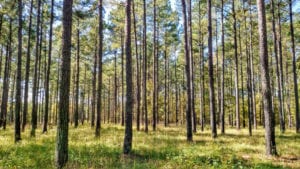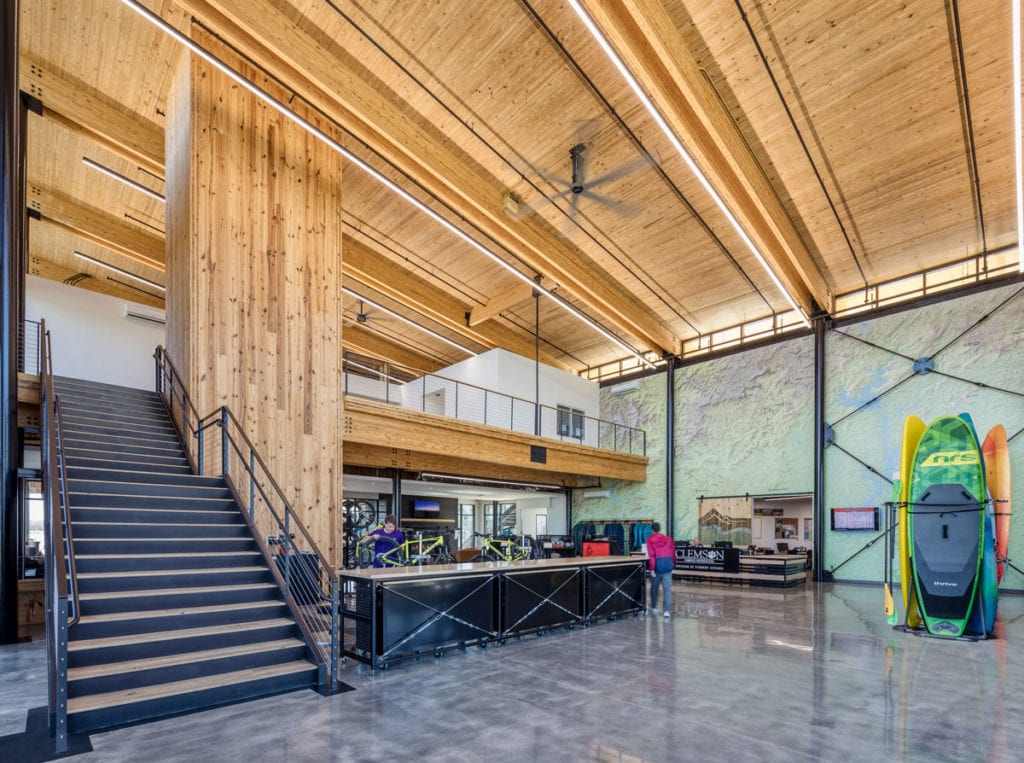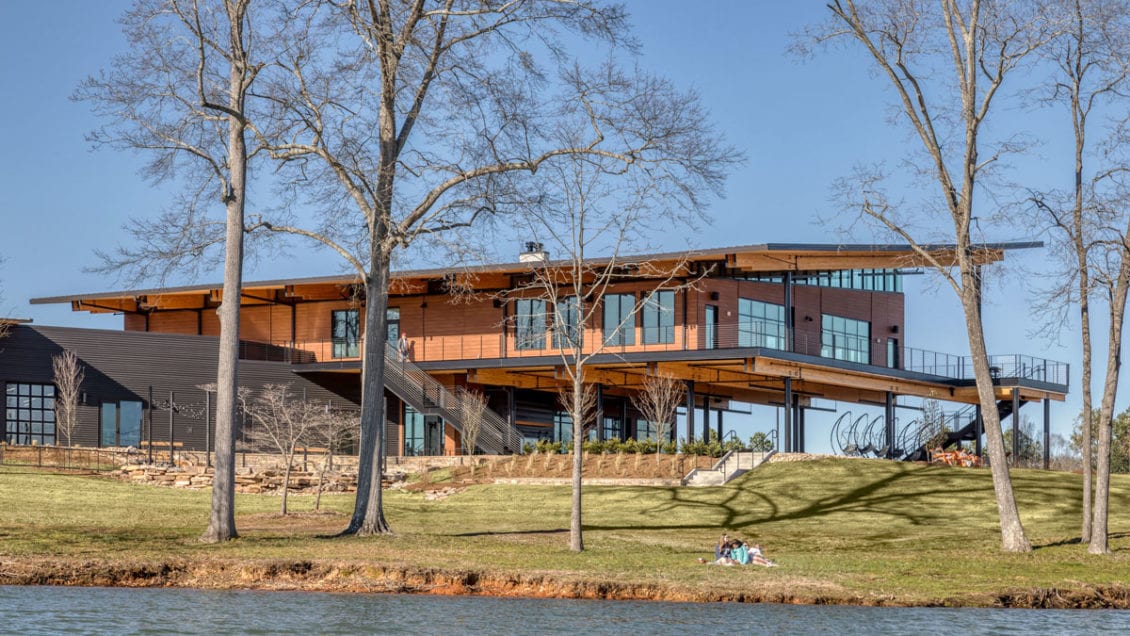When the South Carolina forest products industry desired to grow their timber on longer rotations, they needed a new market for their wood. Although the pulp and paper industries were viable markets, many private landowners wanted to sell their timber as sawlogs in the construction industry and have the lumber live on in buildings, having useful, protected existences.

In 2011, the South Carolina forest products industry asked Clemson University to help expand its market. This was the beginning of how the Andy Quattlebaum Outdoor Education Center came into existence, transforming an industry.
Patricia Layton, professor of forestry at the College of Agriculture, Forestry and Life Sciences (CAFLS) who would later become the director of Clemson University’s Wood Utilization + Design Institute, began working on the issue to help the forest landowners.
She invited WoodWorks (who focuses on wood industry initiatives), the American Wood Council (who helps develop and understands the building codes) and a few others to meet with her, Gerald Vander Mey, director of University Planning and Design, and John McIntyre, a capital engineer, to talk about using mass timber and new, engineered wood materials.
One of the things I learned early on was that in order to make a difference and to make a statement with wood and new building formats, you have to get leaders together, build buildings and be an example to others.
PAT LAYTON, PROFESSOR OF FORESTRY, CAFLS
Over 180,000 private landowners and tree farmers own 87% of forestland in South Carolina, accounting for a large part of the habitat, which directly contributes to the health and quality of life of residents and the state’s economy. Aside from safeguarding wildlife, forests help clean the air and water, provide recreational spaces as well as teaching and research grounds. Overall, the forestry industry contributes 98,000 jobs and $21 billion to the state of South Carolina.
The group discussed if there was interest in trying new engineered wood materials in a process similar to post and beam construction, what that might look like and what the engineering and code challenges would be. At the end of the meeting, Vander Mey said Student Affairs was thinking of building a structure at the Y Beach and suggested that might be a place to try it. The area including Y Beach was a part of the master plan for the west campus entrance. The entire area was later named the Snow Family Outdoor Fitness and Wellness Complex.
At its CORE
Student Affairs and the Department of Campus Recreation oversees the Clemson Outdoor Recreation and Education program known as CORE, providing students with opportunities to participate in outdoor activities from day outings such as hiking local trails, paddleboarding on the lake and whitewater rafting to weeklong trips backpacking, fly fishing, skiing or sea kayaking (pre-COVID-19). Even covering bicycle maintenance, CORE helps students navigate experiences at every skill level, so students can connect with the outdoors and develop lifelong passions.

What CORE needed was a place to reside that was convenient for students and connected them to nature, inviting and inspiring them to become involved and try new activities, an extreme upgrade from the old trailer and hog barn they had used in the past.
With lake access and two top-quality fields that serve club and intramural sports, the Snow Family Outdoor Fitness and Wellness Complex provided a great foundation for students to engage on campus and presented an ideal location to house such a recreation facility.
What we wanted to create was a welcoming environment that invited students who may not have a lot of experience in our outdoor programming to come out and then help them feel comfortable engaging in it. We wanted a destination spot on campus, a place where students could lounge and just socialize if they wanted. We wanted a REI Co-op kind of feel, so students who might not know what they’re looking for could browse without intimidation and maybe just try one thing such as paddleboarding at the lake. The Snow Family Outdoor Fitness and Wellness Complex was the perfect spot.
CHRIS FIOCCHI, SENIOR DIRECTOR OF CAMPUS RECREATION
With a prime location chosen for their new facility, the Student Affairs team began interviewing architects. They searched for partners who were committed to letting them be a part of the design, because campus recreations facilities are very specific. The facilities must serve multiple functions and programs and be able to adapt to future recreational trends.
“When building a campus recreational faciliy, you’re limited with budgets, and you have to make great use of the space and understand how it impacts from a recreational standpoint,” said Fiocchi. “We have a robust fitness and wellness program, so we wanted to be able to leverage the unique beauty of that area to provide some classes. Where we came into the design process was really driving the functionality. As beautiful as the facility is, it’s highly functional and can be used for a lot of different things.”
Setting an example
Knowing they wouldn’t have a second chance to build a facility and that they wanted to leverage the beauty of the area, after the procurement process, the team chose Cooper Carry as the architect; Britt, Peters and Associates as the engineer and Sherman Construction as the contractor to create a showpiece unlike any other building in South Carolina — one that utilized Southern yellow pine. This ground-breaking, multi-purpose facility would eventually be completed in 2019. In 2020, it was named the Andy Quattlebaum Outdoor Education Center, which students, staff and faculty lovingly refer to as “Andy’s.”
Andy’s hybrid design elements include Southern yellow pine CLT that was tested and developed through Clemson’s Wood Utilization + Design Institute. Since its completion, Andy’s has won several awards, including Best Sports/Entertainment award in ENR Southeast’s 2020 Best Projects and a 2021 Wood Design Awards Regional Excellence Winner.
“At the same time we were developing our research and work on mass timber, some of our early students started to work on and develop Southern yellow pine cross-laminated timber. That’s our local species, and that is the material that ended up being used at the Andy Quattlebaum Outdoor Education Center,” said Layton. “That building really started something.”
The Andy Quattlebaum Outdoor Education Center performs all of the tasks intended by the University and designers, but it also has one very important job that emerged from the process. It stands as an example of mass timber construction, inspiring mass timber use in other buildings — several in South Carolina alone.
We’re always inviting people to come tour, and they are always surprised by how modern but natural the Andy Quattlebaum Outdoor Education Center looks, how it connects them to nature and how it makes them feel. We call that biophilic design. It’s warm. It brings the stress levels down, and it makes people want to reach out and touch the wood when they walk by, because they like the sensation. And we’ve worked really hard to help college and university leaders, agency heads and the public and private sectors understand what these wood buildings offer and what wood allows them to do and how it fits into the codes to help raise up this type of building.
PAT LAYTON, PROFESSOR OF FORESTRY, CAFLS
Clemson students, staff and faculty often lead tours through the Andy Quattlebaum Outdoor Education Center, and University staff and faculty frequently speak about the facility, mass timber construction and cross-laminated Southern yellow pine. These tours and presentations have resulted in multiple applications — from recreation and tourism to offices and private residences.
Inspiring the masses
The Parks, Recreation and Tourism brand department of South Carolina have used mass timber in three Welcome Centers: South Carolina Welcome Center in Fort Mill, South Carolina Welcome Center in Dillion and South Carolina Welcome Center in Hardeeville.
Clemson University also included mass timber in the newly built Samuel J. Cadden Chapel on Clemson’s main campus. Other college and school buildings include Wofford College’s Environmental Sciences Building in Spartanburg, The Continuum in Lake City, Ten Oaks Middle School in Myrtle Beach, College of Charleston Admissions Office at Craig Hall, Charles Towne Landing Founders Hall in Charleston and the University of South Carolina-Beaufort at the Hilton Head Island Campus.
Other projects include the Pleasant Ridge Camp and Retreat Center in Marietta, YMCA Camp Thunderbird Duke Energy Pavilion in Lake Wylie, Lynches River Discovery Center in Coward, The Pepper Plantation Pavilion in Mount Pleasant, Louis Waring, Jr. Senior Center in Charleston, James Island Town Hall in James Island, Canoe Club in Palmetto Bluff and even two hotels: Fort Jackson Candlewood Suites in Columbia and Home2Suites in Mount Pleasant.
Current residences are a passive home in Greenville and beach house in Hilton Head. WU+D recently launched an interactive map to document all of the significant wood buildings across South Carolina.
“There are so many reasons to use mass timber — the speed of construction, the quietness of the process, little to almost no construction waste,” said Layton. “It’s an incredible opportunity for us to do more efficient buildings that last for a long time and have that natural beauty, and still be cost effective.”
Both Layton and Fiocchi said had the pricing not been lower than traditional post-and-beam construction, they wouldn’t have been able to do it.
“We were able to build an incredible building under budget and have a huge impact to campus. So, were there hiccups? Absolutely. Were there times we disagreed? Yes. But we all kept our common goals in mind, and we all understood how important this was to Pat,” said Fiocchi. “We worked together and created something that elevated the industry within South Carolina as much as it benefitted and promoted Clemson.”
Andy’s continues to be an inspiration, not just to Clemson students who enjoy its services and environment or invested parties in the state of South Carolina, but also to the nation and beyond.
“As I sit on the porch there and look out, I get emotional,” said Layton. It ties me. It also ties us all to the land and to the will, that legacy of land and resources and doing good. It makes me feel good.”
Get in touch and we will connect you with the author or another expert.
Or email us at news@clemson.edu

